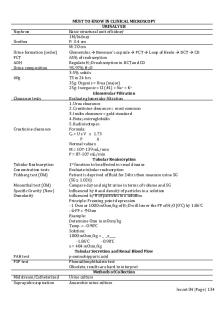Lecture notes – fluorescence microscopy PDF

| Title | Lecture notes – fluorescence microscopy |
|---|---|
| Course | Molecular & Cellular Biology |
| Institution | University of Central Lancashire |
| Pages | 2 |
| File Size | 32.6 KB |
| File Type | |
| Total Downloads | 66 |
| Total Views | 143 |
Summary
These notes are useful for when creating your own revision material...
Description
Lecture notes – fluorescence microscopy
A fluorescence microscope is an optical microscope that uses fluorescence and phosphorescence instead of, or in addition to, reflection and absorption to study properties of organic or inorganic substances. Fluorescence is the emission of light by a substance that has absorbed light or other electromagnetic radiation while phosphorescence is a specific type of photoluminescence related to fluorescence. Unlike fluorescence, a phosphorescent material does not immediately re-emit the radiation it absorbs.
Most fluorescence microscopes in use are epifluorescence microscopes, where excitation of the fluorophore and detection of the fluorescence are done through the same light path (i.e. through the objective).
A light source Four main types of light sources are used, including xenon arc lamps or mercury-vapor lamps with an excitation filter, lasers, and high- power LEDs. Lasers are mostly used for complex fluorescence microscopy techniques, while xenon lamps, and mercury lamps, and LEDs with a dichroic excitation filter are commonly used for wide-field epifluorescence microscopes. The excitation filter The exciter is typically a bandpass filter that passes only the wavelengths absorbed by the fluorophore, thus minimizing the excitation of other sources of fluorescence and blocking excitation light in the fluorescence emission band. The dichroic mirror A dichroic filter or thin-film filter is a very accurate color filter used to selectively pass light of a small range of colors while reflecting other colors.
Fluorophores lose their ability to fluoresce as they are illuminated in a process called photobleaching. Photobleaching occurs as the fluorescent molecules accumulate chemical damage from the electrons excited during fluorescence. Cells are susceptible to phototoxicity, particularly with short-wavelength light. Furthermore, fluorescent molecules have a tendency to generate reactive chemical species when under illumination which enhances the phototoxic effect. Unlike transmitted and reflected light microscopy techniques fluorescence microscopy only allows observation of the specific structures which have been labeled for fluorescence.
The sensitivity is high enough to detect as few as 50 molecules per cubic micrometer. Different molecules can now be stained with different colors, allowing multiple types of the molecule to be tracked simultaneously. These factors combine to give fluorescence microscopy a clear advantage over other optical imaging techniques, for both in vitro and in vivo imaging....
Similar Free PDFs

Microscopy - Lecture notes 2
- 3 Pages

Fluorescence
- 14 Pages

different microscopy
- 4 Pages

Fluorescence SQ’s & MCQ’s
- 5 Pages

Techniques de fluorescence
- 2 Pages

CM-handouts - Clinical Microscopy
- 32 Pages

MUST-KNOW Clinical Microscopy
- 43 Pages

Microbiology labster microscopy
- 4 Pages

microscopy workshop 2 analysis
- 14 Pages

Greenwood Microscopy Mitosis Lab
- 13 Pages

Optics & Microscopy summary
- 27 Pages
Popular Institutions
- Tinajero National High School - Annex
- Politeknik Caltex Riau
- Yokohama City University
- SGT University
- University of Al-Qadisiyah
- Divine Word College of Vigan
- Techniek College Rotterdam
- Universidade de Santiago
- Universiti Teknologi MARA Cawangan Johor Kampus Pasir Gudang
- Poltekkes Kemenkes Yogyakarta
- Baguio City National High School
- Colegio san marcos
- preparatoria uno
- Centro de Bachillerato Tecnológico Industrial y de Servicios No. 107
- Dalian Maritime University
- Quang Trung Secondary School
- Colegio Tecnológico en Informática
- Corporación Regional de Educación Superior
- Grupo CEDVA
- Dar Al Uloom University
- Centro de Estudios Preuniversitarios de la Universidad Nacional de Ingeniería
- 上智大学
- Aakash International School, Nuna Majara
- San Felipe Neri Catholic School
- Kang Chiao International School - New Taipei City
- Misamis Occidental National High School
- Institución Educativa Escuela Normal Juan Ladrilleros
- Kolehiyo ng Pantukan
- Batanes State College
- Instituto Continental
- Sekolah Menengah Kejuruan Kesehatan Kaltara (Tarakan)
- Colegio de La Inmaculada Concepcion - Cebu




